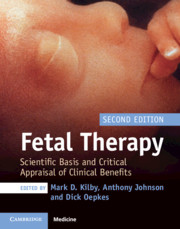Book contents
- Fetal Therapy
- Fetal Therapy
- Copyright page
- Dedication
- Contents
- Contributors
- Foreword
- Section 1: General Principles
- Chapter 1 The Rationale for Fetal Therapy
- Chapter 2 A Fetal Origin of Adult Disease
- Chapter 3 Human Embryology: Molecular Mechanisms of Embryonic Disease
- Chapter 4 Human Genetics and Fetal Disease: Assessment of the Fetal Genome
- Chapter 5 Interventions in Pregnancy to Reduce Risk of Stillbirth
- Chapter 6 Fetal Therapy Choices: Uncertain and Emotional Decisions and the Doctor’s Role in Parental Decision-Making
- Chapter 7 The Ethics of Consent for Fetal Therapy
- Chapter 8 Open Fetal Surgery: Is There Still a Role?
- Chapter 9 The Artificial Womb
- Section 2: Fetal Disease: Pathogenesis and Treatment
- Section III: The Future
- Index
- References
Chapter 6 - Fetal Therapy Choices: Uncertain and Emotional Decisions and the Doctor’s Role in Parental Decision-Making
from Section 1: - General Principles
Published online by Cambridge University Press: 21 October 2019
- Fetal Therapy
- Fetal Therapy
- Copyright page
- Dedication
- Contents
- Contributors
- Foreword
- Section 1: General Principles
- Chapter 1 The Rationale for Fetal Therapy
- Chapter 2 A Fetal Origin of Adult Disease
- Chapter 3 Human Embryology: Molecular Mechanisms of Embryonic Disease
- Chapter 4 Human Genetics and Fetal Disease: Assessment of the Fetal Genome
- Chapter 5 Interventions in Pregnancy to Reduce Risk of Stillbirth
- Chapter 6 Fetal Therapy Choices: Uncertain and Emotional Decisions and the Doctor’s Role in Parental Decision-Making
- Chapter 7 The Ethics of Consent for Fetal Therapy
- Chapter 8 Open Fetal Surgery: Is There Still a Role?
- Chapter 9 The Artificial Womb
- Section 2: Fetal Disease: Pathogenesis and Treatment
- Section III: The Future
- Index
- References
Summary
Making good decisions prospectively is difficult, especially when there is the perception that the stakes are high. There is often uncertainty regarding prognosis and emotions prevail both between a couple and in the interactions with their healthcare professional team. This is the case when parents have to decide about fetal therapy for congenital malformations and the health of their unborn child. Parents are usually unprepared for the often rare disease the fetus is found to have. Still in a state of shock, they receive a lot of detailed and difficult information, and need to decide whether to choose fetal therapy (which often carries risks of perinatal death or preterm birth as complications), expectant management, or sometimes the very difficult option of termination of pregnancy. The obstetrician or fetal medicine specialist aims to provide the parents with all the relevant factual information and to support them in their decision process.
- Type
- Chapter
- Information
- Fetal TherapyScientific Basis and Critical Appraisal of Clinical Benefits, pp. 61 - 68Publisher: Cambridge University PressPrint publication year: 2020

